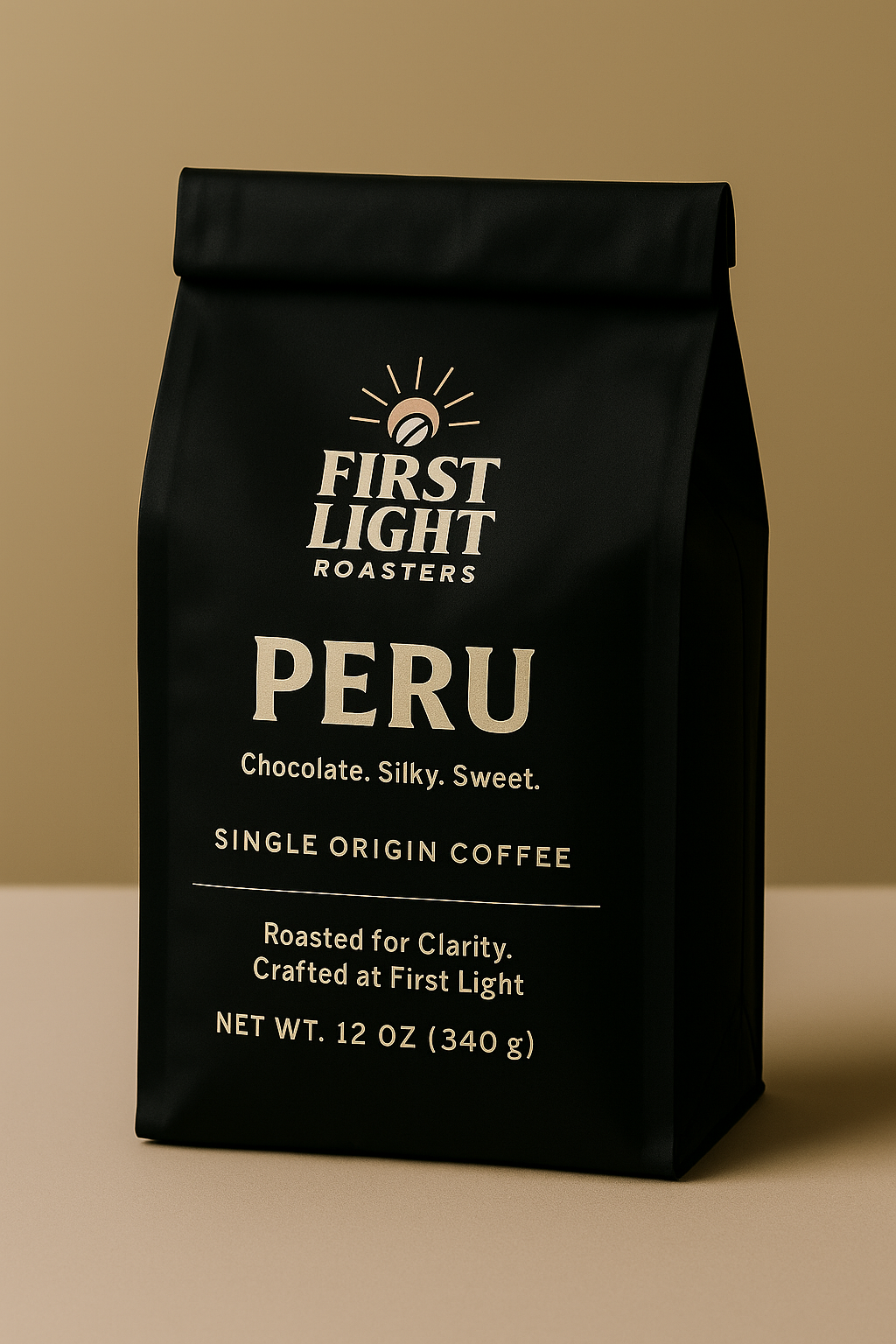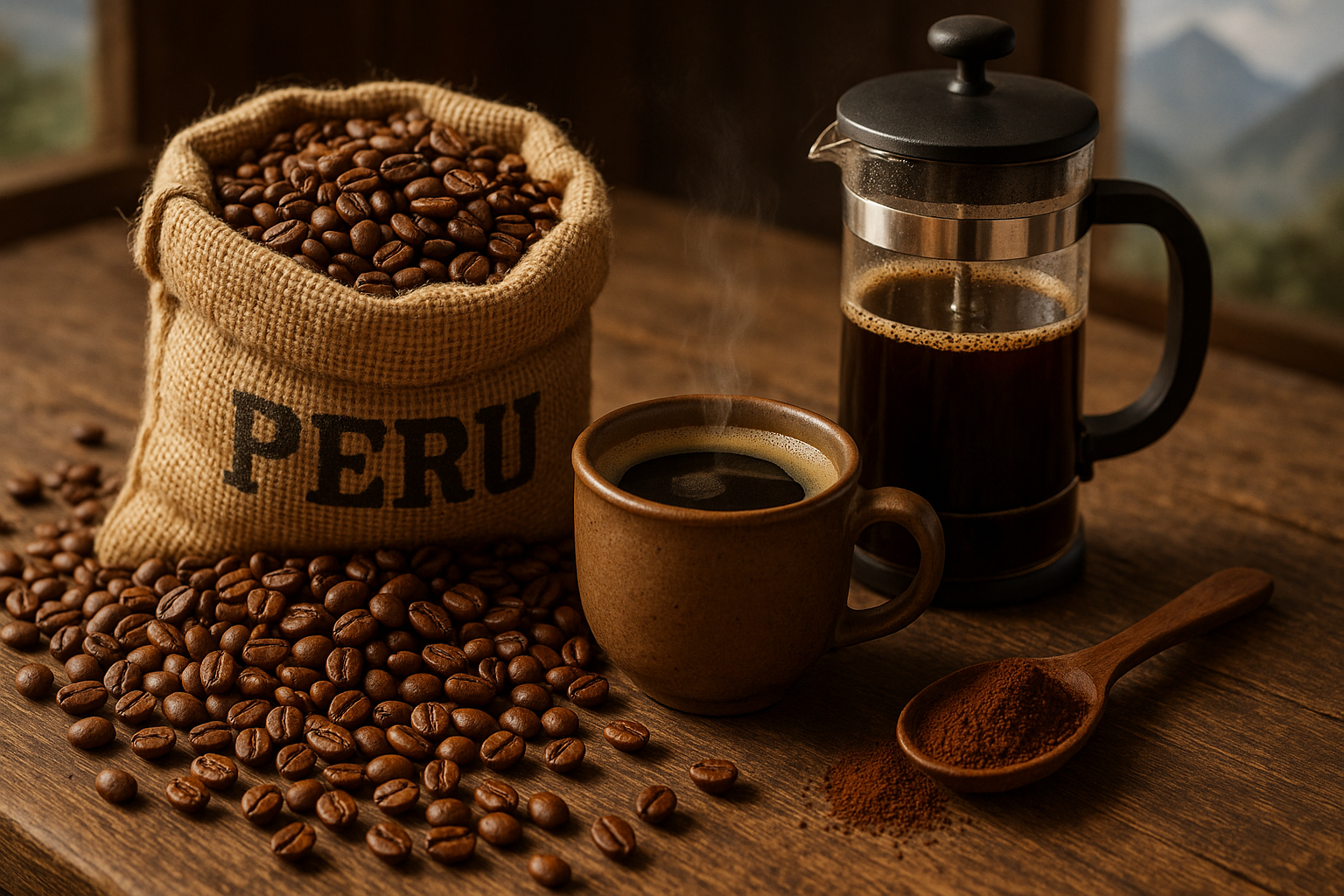Article: What Are the Best Brewing Methods for Peruvian Coffee

What Are the Best Brewing Methods for Peruvian Coffee
When you choose a high-quality single origin coffee like Peruvian, how you brew it makes all the difference. Peruvian coffee is known for its smooth, balanced profile and clean finish. It features mild citrus notes, soft florals, gentle nutty undertones and milk chocolate sweetness. But to bring those flavors to life, you need the right brewing method.
Different methods emphasize different characteristics in the coffee. Some enhance brightness and clarity, while others draw out body and sweetness. If you’re using Peruvian coffee from First Light Roasters or any other specialty source, this guide will help you choose the ideal way to brew it.
In this blog, we’ll explore the top brewing methods for Peruvian coffee and explain how each one affects the taste. Whether you prefer a bright pour over or a full-bodied French press, you’ll learn how to unlock the full potential of your beans.
What Makes Peruvian Coffee Unique
Before getting into the brewing techniques, let’s revisit what makes Peruvian coffee special. The best Peruvian coffees are grown at high altitudes in regions like Cajamarca, Cusco and Amazonas. These elevations, often above 1500 meters, lead to slow cherry maturation, dense beans and a refined flavor profile.
Peruvian beans are usually washed processed. This means they are cleaned and fermented to remove the fruit before drying. Washed coffees tend to be bright, clean and elegant in the cup. Peruvian varieties often feature:
-
Bright citrus like orange or lemon
-
Mild stone fruits such as peach or apple
-
Milk chocolate or cocoa
-
Almond or cashew nuttiness
-
Medium body with a clean, dry finish
Because of this balance and clarity, Peruvian coffee adapts well to several brewing methods — but certain techniques bring out its best qualities more than others.
1. Pour Over
Best for: Highlighting clarity and acidity
The pour over method — using a V60, Chemex or Kalita Wave — is one of the best ways to enjoy Peruvian coffee. This manual brew style offers complete control over extraction. It allows the water to gently pass through the grounds, bringing out clean and crisp flavors.
To brew Peruvian coffee as a pour over:
-
Use a light to medium roast
-
Grind to medium-fine (like sea salt)
-
Use a 1 to 16 coffee to water ratio
-
Water temperature: 195 to 205°F
-
Total brew time: 2.5 to 3 minutes
Expect a clean cup with notes of citrus, floral aroma and a refreshing finish. This method emphasizes the brightness and sweetness of Peruvian beans without any muddiness.
2. French Press
Best for: Full body and mellow sweetness
The French press is ideal for those who prefer a heavier mouthfeel. This method uses full immersion, which allows coffee oils and fine particles to remain in the brew. The result is a rounder, richer flavor.
To brew with a French press:
-
Use a medium or medium-dark roast
-
Grind coarsely (like breadcrumbs)
-
Coffee to water ratio: 1 to 15
-
Steep time: 4 minutes
-
Plunge slowly and avoid disturbing sediment
With Peruvian coffee, a French press brings out chocolate and nutty notes while softening the acidity. It’s a comforting, smooth cup — perfect for cold mornings or those who add milk.
3. AeroPress
Best for: Sweet balance and travel-friendly brewing
The AeroPress is a compact, versatile tool that delivers a sweet and smooth brew. It works using air pressure to push water through the grounds. You can brew as a short concentrate or a longer filter-style cup.
To use the AeroPress:
-
Use a medium roast
-
Grind medium-fine
-
Coffee to water: 17 grams to 250 ml
-
Steep for 1 minute, then press for 30 seconds
AeroPress preserves sweetness and balance. With Peruvian coffee, it highlights subtle chocolate and nut notes with a creamy body and a crisp finish. It’s especially good if you want something easy to brew with great clarity.
4. Espresso
Best for: Intensity and milk-based drinks
Espresso is a more advanced method, but it can work beautifully with Peruvian coffee when roasted and dialed in properly. Because Peruvian beans are often light or medium roast, they require careful pressure and grind adjustments.
If you’re using Peruvian coffee as espresso:
-
Choose a medium roast or medium-dark
-
Grind very fine
-
Use 18 to 20 grams for a double shot
-
Brew in 25 to 30 seconds at 9 bars of pressure
Expect a mild citrus acidity, a light chocolate body and floral aroma. The crema will be soft and golden. This shot works great alone or in a flat white or cappuccino, where its balanced profile cuts through milk gently.
5. Cold Brew
Best for: Refreshing, low-acid sweetness
Cold brew is a method where ground coffee steeps in cold water for 12 to 18 hours. It produces a low-acid, smooth drink that’s served cold and often diluted. With Peruvian coffee, cold brew draws out cocoa and nut notes with a mellow finish.
To make cold brew:
-
Use coarsely ground coffee
-
Coffee to water: 1 to 8 ratio
-
Steep in fridge for 12 to 16 hours
-
Filter and serve over ice
The result is smooth, sweet and easy to drink. It’s a great way to enjoy Peruvian coffee on a warm day or for those who want a lower-acid option.
6. Drip Coffee Maker
Best for: Convenience and daily brewing
Automatic drip brewers are a staple in many homes. They don’t offer the same level of control as manual methods, but when paired with fresh Peruvian beans, they still produce a solid cup.
To get the best result:
-
Use fresh, whole beans and grind right before brewing
-
Medium grind size
-
Use a water ratio of 1 to 15
-
Clean your machine regularly
With this method, Peruvian coffee maintains its balance and mildness. It’s a dependable everyday option that works well for both black coffee and light additions like milk or oat milk.
Which Method Should You Choose
Each brewing method brings something different to the table:
-
Choose pour over if you want to taste every detail of origin.
-
Use French press for comfort and richness.
-
Go with AeroPress for sweet, portable balance.
-
Try espresso for milk drinks and intensity.
-
Use cold brew for low-acid, chilled refreshment.
-
Pick drip machines for convenience.
The best method depends on your personal taste and lifestyle. If you have time in the morning, try a V60 or Chemex. If you want a quick fix, go with a drip maker. All will bring out unique sides of your Peruvian beans.
Final Thoughts
Peruvian coffee is versatile and adaptable. Thanks to its clean profile, gentle acidity and smooth finish, it performs well across a variety of brew methods. But the best way to enjoy it is the way that fits your routine.
At First Light Roasters, we roast our Peruvian single origin coffee to work beautifully in pour over, AeroPress and drip methods. It’s bright and elegant when you need clarity, but also round and sweet when you want comfort.
Try different methods and see what speaks to you. Your perfect cup might be just one brew away.


